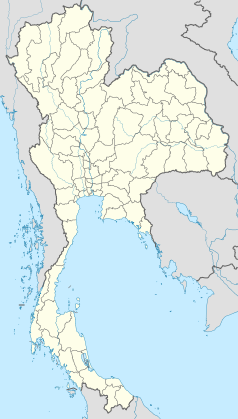Uniwersytet Chulalongkorna
 | |
 Pierwszy budynek Wydziału Inżynierii | |
| Data założenia | 26 marca 1917 |
|---|---|
| Typ | |
| Patron | |
| Państwo | |
| Adres | |
| Liczba studentów | 37 625 |
| Strona internetowa | |
| Ranking | |
|---|---|
| National Ranking | |
| QS Asia (2016) | 1[1] |
| QS World (2016) | 1[2] |
| QS GER (2017) | 1[3] |
| CWUR (2016) | 1[4] |
| RUR (2016) | 1[5] |
| CWTS (2016) | 1[6] |
| THE World (2016) | 2[7] |
| SIR (2016) | 2[8] |
| Nature Index (2016) | 1[9] |
| U.S. News (2016) | 2[10] |
| UI Green Metric (2015) | 1[11] |
| Global | |
| QS Asia (2016) | 45[1] |
| QS World (2016) | 252[2] |
| QS GER (2017) | 151-200[3] |
| CWUR (2016) | 320[4] |
| RUR (2016) | 424[5] |
| CWTS (2016) | 432[6] |
| THE World (2016) | 601 -800[7] |
| SIR (2016) | 475[8] |
| U.S. News (2016) | 579[10] |
| UI Green Metric (2015) | 30[11] |
Uniwersytet Chulalongkorna[12] – tajlandzki uniwersytet w Bangkoku, najstarszy w kraju. Nazwany jest imieniem króla Chulalongkorna (Ramy V), a założony został przez jego następcę Vajiravudha (Ramę VI) w 1917 roku.
Pod koniec XIX wieku zapotrzebowanie na urzędników specjalizujących się w różnych dziedzinach było wynikiem reform króla Chulalongkorna, który zmierzał do przekształcenia społeczeństwa feudalnego w nowoczesne. W 1899 król założył Szkołę Służby Cywilnej (taj. โรงเรียนสำหรับฝึกหัดวิชาข้าราชการฝ่ายพลเรือน) w pobliżu północnej bramy pałacu królewskiego.
Uczelnia ma 18 wydziałów. Kampus uniwersytecki zajmuje ogromną powierzchnię w dolnym Bangkoku, a studenci często mieszkają w okolicach placu Siam.
Znani absolwenci
- Mahidol Adulyadej
- Galyani Vadhana
- Maha Chakri Sirindhorn
- Sirivannavari Nariratana
- Banjong Pisanthanakun
- Surakiart Sathirathai
- Win Lyovarin
- Binlah Sonkalagiri
- Thongchai Winichakul
- Borwornsak Uwanno
- Kiatisuk Senamuang
- Sukhumbhand Paribatra
- Suporn Watanyusakul
- Pakorn Chatborirak
- Chit Phumisak
Przypisy
- ↑ a b QS University Rankings: Asia 2016, 8 czerwca 2016 [dostęp 2016-09-16].
- ↑ a b QS World University Rankings 2016, 25 sierpnia 2016 [dostęp 2016-09-16].
- ↑ a b Graduate Employability Rankings 2016, „Top Universities”, 17 listopada 2016 [dostęp 2016-11-24].
- ↑ a b CWUR 2016 | Top Universities in Thailand [dostęp 2016-09-16].
- ↑ a b Super User, RANKINGS [dostęp 2016-09-16].
- ↑ a b CWTS Leiden Ranking 2016, CWTS [dostęp 2016-09-16].
- ↑ a b World University Rankings, 30 września 2015 [dostęp 2016-09-16].
- ↑ a b Scimago Institutions Rankings [dostęp 2016-09-16].
- ↑ 2016 tables: Institutions. Nature Index [dostęp 2016-09-16].
- ↑ a b Best Global Universities Rankings [dostęp 2016-09-16].
- ↑ a b Overall Ranking 2015 | Greenmetric UI [dostęp 2016-09-16] [zarchiwizowane z adresu 2020-10-27].
- ↑ Adam Robiński: Chulalongkorn w Warszawie, „Rzeczpospolita”, 5 maja 2012
Linki zewnętrzne
- Witryna internetowa Uniwersytetu Chulalongkorna (taj. • ang.)
Media użyte na tej stronie
The national flag of Kingdom of Thailand since September 2017; there are total of 3 colours:
- Red represents the blood spilt to protect Thailand’s independence and often more simply described as representing the nation.
- White represents the religion of Buddhism, the predominant religion of the nation
- Blue represents the monarchy of the nation, which is recognised as the centre of Thai hearts.
Phra Kiao, the personal insignia of King Chulalongkorn and the emblem of Chulalongkorn University, which is named after him. This image is a derivative work from the regulation on uniform for CU personnel which is published in the Thai Government Gazette. Therefore, this work is not eligible for copyright, but the usage is governed by other laws.
There are a number of variations of this emblem (different in crown components, hanging brushes, pillow and so on.) in order to meet aesthetic purposes.





